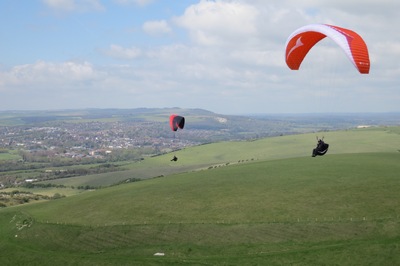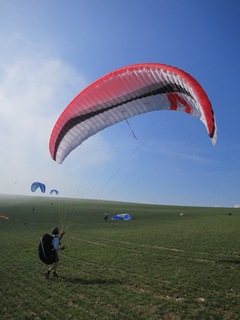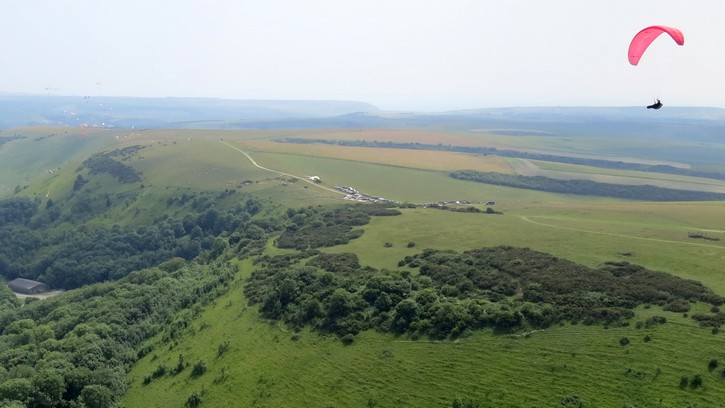
Low-airtime paraglider pilot Ked Shayer found that he made some big improvements in his flying this year. He even won some prizes! Wisely, Ked noted down some of the things he learned so he could refer back to them later. We thought his notes would also be useful for other new pilots to read so, with Ked's permission, we've published them here for your benefit with bonus expert commentary from Carlo at Flybubble.
Low-airtime Paragliding Tips from The Summer
By Ked Shayer
This year has seen a big improvement in my flying; from nervous CP to 3000 ft above Bo Peep and making consistent height gains in thermals. I have a four week lay-off and won't be back on the hill until mid-October; summer has been pretty good so winter's bound to be rubbish. As a result I wanted to try to record some of the things I've learned this year so I can refer back to them next spring. Hopefully this might be of use to others, and please add anything you picked up over the summer!
Also hopefully some good pilots will check everything I've written. With only 25 hours flying my tips probably shouldn't be totally trusted...
General flying
Speed-to-fly makes a huge difference when ridge soaring. In light conditions it's good to be hands-up almost all the time, either turning or coming down to min-sink in good patches of lift. Working on this has kept me up in conditions I would have gone straight down in earlier in the year. If you can find a place to practise safely, the amount of brake you can use to go down to min sink is probably more than you realise (just don't stall!). On a windy day at the Dune of Pilat (also called Grande Dune du Pilat) in France I was practising slow flying and had aching triceps at the end of the day from keeping so much brake pressure on...
Carlo: Great tip re using proper speed-to-fly making a big difference to how well you stay up when soaring in thermodynamic conditions! Just be careful about flying with too much brake and risking stalling; you definitely won't stay up if you stall your wing - and it's likely to hurt! ;) I hardly ever fly at, or even near, minimum sink (min sink), even in smooth buoyant air, mainly due to the risk of stalling. Plus if you're flying slow and encounter sink you will lose a lot more height. I prefer to fly a little faster and just try to stay in the area of lift as best I can through manoeuvring as efficiently as possible. You definitely shouldn't get aching triceps, unless your arms are too tense and/or your glider's brake pressure is very heavy. Try to relax and use plenty of weight-shift in turns!
If you are getting low, it's best to slope land and kite/walk up early. This way saves a long walk up, getting tired and wasting energy that could be spent in the air.
Carlo: A deceptively simple, but incredibly useful, tip! Many paraglider pilots seem to be hill-walking shy, so shouldn't need to be told this tip. ;) The problem is if you've gone and let yourself sink all the way to the bottom, because you didn't slope land early enough, it might already be too late for you - and your legs!

If you can't get out flying it's worth trying to ground handle. I've tried to get under my wing at least once a week, so even when I haven't flown for a month or so it's never been more than a few days since I've used my glider. This has been really good for my confidence. (SHGC tip: Evenings at Mount Caburn are often good; either at the bottom if the sea breeze is still strong or, in light winds, walking up for a ground handle and top-to-bottom.)
Carlo: Another great tip for things to do when it's not flyable, Ked! I'll just add to this that pilots should also use unflyable weather as an opportunity to study-up on the theory side of things. A big part of being a good pilot is to know and understand the theory, especially as regards aerodynamics, meteorology and airmanship. Of course there's the air law side of things too. If you are flying around in blissful ignorance then you are a serious danger to yourself and others - you just don't realise it! There's a lot to learn so you need to actively seek out good knowledge. Fortunately there's a lot of good information that's easily available nowadays in the form of educational books and DVDs etc. Unfortunately there's even more bad information which easily available too, especially on internet forums and YouTube!
Try to make sure your hands are really right at the stoppers when taking off, it makes all the difference! It's worth getting a friend to watch you as I thought I was good at this at the start of the year, but was trying to take off with a good foot of brake on! You may need to lean forward so your body is parallel with the ground to get your hands right up.
It's worth learning the cobra launch for strong wind inflations. A good tip to get the glider in the right position is to pull one A riser up a little then walk towards that side of the wing. Doing this a few times gets the wind lying across the wind.
Carlo: Although the full cobra launch can work for strong wind inflations, it's not something that I tend to use in real situations. It's fun to play around with, and a great party trick though! I do however sometimes use an asymetric launch (bringing one tip up before the other, rather than the whole wing together) for strong wind inflations, which is similar to a full cobra launch but not quite as 'extreme'.

Get some coaching! My first UK coaching session got me from never having been more than 100 m above the hill to 3000 ft! And more than that taught me how to be reasonably consistent in thermaling. I'm sure lots of instructors do coaching sessions, but I can only personally vouch for Flybubble's Pilot Coaching - £50 for half a day and that much progress was a bargain and I'll be doing a lot more of it!
Be careful with the wind around a conical hill (e.g. Mount Caburn in East Sussex, England) - it's caught me out a few times this summer ending up being in a bit of rotor or doing downwind-ish slope landings because I didn't realise how far the air had turned around the hill or how strong the Venturi by the beginner slope was.
Carlo: One of the most important things that all soaring pilots need to learn - as soon as possible - is how to visualise the airflow, which is of course invisible! Where's the best lift? Where are the areas of turbulence, rotor, Venturi etc?
Making detailed notes in a log-book helps you remember everything you've learned. I try to do a summary of the day, good and bad points.
Thermal flying
I've found turning when I feel the lift to be a better method than turning when the lift starts to reduce. If in doubt turn tighter seems to work for me!
Carlo: If the thermal is small then turning soon and tight to stay in it ('coring method') is undoubtedly the best way. It's also a simpler method for thermaling pilots to start off with: turn in lift! However this limits you to only turning in the first bit of lift you encounter. What if there's better lift just further on? Then the 'searching method' (straighten when lift increases; turn when lift decreases) works best. I tend to switch between the searching and coring methods frequently when thermaling.
A good method for starting a 360 is to weight shift hard to one side, count to three, and then pull on some inside brake. Once the turn is banked over a bit it's good to pull on a little outside brake which I find calms the glider down a little. I could still weight shift harder in my turns and will keep working on that.
I heard the phrase following lifty lines before but never knew what it meant. Greg (Flybubble) gave me a tip on this, which is to go along the ridge waiting for a small lifty patch. This is probably a bit of a thermal out front, which has been blown onto the hill by the wind. Having flown into a nice lifty patch turn into the wind and go hands up. This will let you really feel the wing. If you are following a lifty line it will try to push you to one side; weight shift against it to keep on the same line, you may have to do this a few times. Eventually, you should be rewarded by a big thermal! This summer I've found a lifty line has been about 0.5 m/s on the vario, and a thermal worth turning in has been 1.5 to 2 m/s (before starting to turn).
Carlo: When done right, this is effectively following the thermal searching method!

If it's a nice day it's worth trying to get off the ridge; there should be lifty patches around and this keeps you away from the crowds, and makes you first in the thermals! Fly back fast (hands up) as soon as you get as low as take-off level though.
On the other hand if it's very light it may be a case of starting off turning in light thermals on the ridge, as there may not be any lifty lines. When low and on the ridge but having felt a thermal start doing figures of eight. To do these tight enough they start to feel a bit like wingovers to me (not that I've ever tried to wingover) i.e. I feel lift, check airspace and then turn 180 quite hard with a lot of weight shift. As soon as I swing back under the glider I start to turn 180 the other way. In a nice little thermal after a few 180s you should be high enough to start 360ing.
Carlo: Blimey, Ked. You really were paying attention during those pilot coaching sessions! ;-)
You can turn in a thermal and find that at the end of the 360 you get shot up into the air, have to go hands up to keep the glider above your head, and are unable to keep turning without pulling loads of brake on any potentially spinning. Greg says you can anticipate this, go hands up before the really lifty patch, then turn into it hard with the speed you have from having gone hands up. Supposedly small powerful patches happen often when the sea breeze is starting to come in. I haven't managed this technique yet, something to keep trying!
Carlo: A very good tip, requiring quite advanced handling and a very good feel of your glider's spin point. Not recommended for pilots who haven't yet mastered their wing control.
Once thermaling look everywhere! Check airspace, watch any other gliders in the thermal (if they are going up faster than you try to get in the bit of air they're in), watch gliders below you and around you – are others going up faster, even if they're in a different thermal? Go there! If you are towards the top of a thermal, look for other gliders climbing to fly to.
Carlo: Excellent advice! Always remember though: Every pilot's number one priority must always be to fly safely and considerately with others. This frequently means that you have to forgo flying exactly how and where you want to. Just because you think other pilots are 'in your way' or aren't circling in the best lift doesn't mean you can turn aggressively to push them out. That's just poor airmanship and attitude. A much better idea could be to have a friendly chat with the pilot later and see if you can help them to thermal better so you can both climb better together next time!

Be careful on thermic days, especially if they're windy. It could be worth waiting an hour if it's very bumpy. Find someone you can trust to give you an honest assessment of the conditions.
Carlo: If the conditions are good for flying, then get up there and FLY as much as you can! Don't waste precious good flying conditions faffing or nattering, stupid. If the conditions are not good (for you) then don't fly. Nothing's going to spoil your enjoyment and progress like getting injured. Wait to fly later and live to fly another day!
Thanks to everyone who's helped me improve this year, especially Boris and Matt for getting much better than me and spurring me on! Let's hope autumn is good too!
Brought to you by Flybubble
Love what we do? Want to see more? There’s no better way to support our efforts than buying equipment from us. We’ll ensure you get great service! Choose from our great range AND enable us to do more to benefit the freeflight community.


